
Kyoto Gosho
Encyclopedia
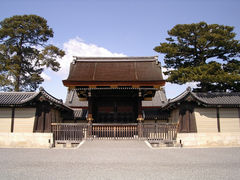
Japan
Japan is an island nation in East Asia. Located in the Pacific Ocean, it lies to the east of the Sea of Japan, China, North Korea, South Korea and Russia, stretching from the Sea of Okhotsk in the north to the East China Sea and Taiwan in the south...
, though the Emperor of Japan
Emperor of Japan
The Emperor of Japan is, according to the 1947 Constitution of Japan, "the symbol of the state and of the unity of the people." He is a ceremonial figurehead under a form of constitutional monarchy and is head of the Japanese Imperial Family with functions as head of state. He is also the highest...
is not in residence. The Emperor has resided at the Tokyo Imperial Palace since 1869 (Meiji Restoration
Meiji Restoration
The , also known as the Meiji Ishin, Revolution, Reform or Renewal, was a chain of events that restored imperial rule to Japan in 1868...
) and ordered the preservation of the Kyōto
Kyoto
is a city in the central part of the island of Honshū, Japan. It has a population close to 1.5 million. Formerly the imperial capital of Japan, it is now the capital of Kyoto Prefecture, as well as a major part of the Osaka-Kobe-Kyoto metropolitan area.-History:...
Imperial Palace in 1877.
Today the grounds are open to the public, and the Imperial Household Agency
Imperial Household Agency
The is a government agency of Japan in charge of the state matters concerning Japan's imperial family and also keeping the Privy Seal and the State Seal...
hosts public tours of the buildings several times a day.
The Kyōto Imperial Palace is the latest of the imperial palaces built at or near its site in the north-eastern part of the old capital on Heiankyō after the abandonment of the larger original that was located to the west of the current palace during the Heian Period
Heian period
The is the last division of classical Japanese history, running from 794 to 1185. The period is named after the capital city of Heian-kyō, or modern Kyōto. It is the period in Japanese history when Buddhism, Taoism and other Chinese influences were at their height...
. The Palace lost much of its function at the time of the Meiji Restoration
Meiji Restoration
The , also known as the Meiji Ishin, Revolution, Reform or Renewal, was a chain of events that restored imperial rule to Japan in 1868...
, when the capital functions were moved to Tōkyō
Tokyo
, ; officially , is one of the 47 prefectures of Japan. Tokyo is the capital of Japan, the center of the Greater Tokyo Area, and the largest metropolitan area of Japan. It is the seat of the Japanese government and the Imperial Palace, and the home of the Japanese Imperial Family...
in 1869. However, the Taishō
Emperor Taishō
The was the 123rd emperor of Japan, according to the traditional order of succession, reigning from 30 July 1912, until his death in 1926.The Emperor’s personal name was . According to Japanese customs, the emperor has no name during his reign and is only called the Emperor...
and Showa
Hirohito
, posthumously in Japan officially called Emperor Shōwa or , was the 124th Emperor of Japan according to the traditional order, reigning from December 25, 1926, until his death in 1989. Although better known outside of Japan by his personal name Hirohito, in Japan he is now referred to...
Emperors
Emperor of Japan
The Emperor of Japan is, according to the 1947 Constitution of Japan, "the symbol of the state and of the unity of the people." He is a ceremonial figurehead under a form of constitutional monarchy and is head of the Japanese Imperial Family with functions as head of state. He is also the highest...
still had their coronation ceremonies at Kyōto Gosho.
The buildings and grounds
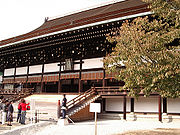
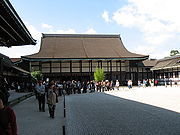
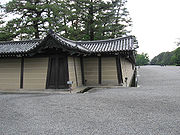
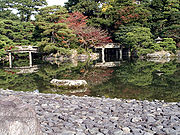
Sento Imperial Palace
The Sentō Imperial Palace or Sentō-gosho is a large garden in Kyoto, Japan, formerly the grounds of a palace for retired emperors...
gardens. The Gyoen dates from the early Edo Period when the residence of high court nobles were grouped close together with the Palace and the area walled. When the capital was moved to Tokyo, the residences of the court nobles were demolished and most of Kyōto Gyoen is now a park open to the public.
The Imperial Palace has been officially located in this area since the final abandonment of the Daidairi in late 12th century. However, it was already much earlier that the de facto residence of the emperors was often not in the of the original Heian period palace, but in one of the in this part of the city and often provided to the emperor by powerful noble families. The present palace is a direct successor - after iterations of rebuilding - to one of these sato-dairi palaces, the of the Fujiwara clan. The Palace, like many of the oldest and most important buildings in Japan, was destroyed by fire and rebuilt many times over the course of its history. It has been destroyed and rebuilt eight times, six of them during the 250-year-long peace of the Edo Period
Edo period
The , or , is a division of Japanese history which was ruled by the shoguns of the Tokugawa family, running from 1603 to 1868. The political entity of this period was the Tokugawa shogunate....
. The version currently standing was completed in 1855, with an attempt at reproducing the Heian Period
Heian period
The is the last division of classical Japanese history, running from 794 to 1185. The period is named after the capital city of Heian-kyō, or modern Kyōto. It is the period in Japanese history when Buddhism, Taoism and other Chinese influences were at their height...
architecture and style of the original Dairi of the Heian Palace
Heian Palace
The Heian Palace was the original imperial palace of Heian-kyō , the capital of Japan, from 794 to 1227. In Japan, this palace is called Daidairi...
.
The Palace Grounds include a number of buildings, along with the Imperial Residence, or dairi (内裏). The neighboring building to the north is the sentō (仙洞), or residence of the retired Emperor, and beyond that, across Imadegawa Avenue, sits Dōshisha University
Doshisha University
, or is a prestigious private university in Kyoto, Japan. The university has approximately 27,000 students on three campuses, in faculties of theology, letters, law, commerce, economics, policy, and engineering...
. The Imperial Household Agency
Imperial Household Agency
The is a government agency of Japan in charge of the state matters concerning Japan's imperial family and also keeping the Privy Seal and the State Seal...
maintains the building and the grounds. They also run public tours, requiring a passport or Alien Registration Card and at least 20 minutes advance notice before allowing foreign visitors into the Imperial Palace.
The main building on the Palace Grounds includes, among other halls, the Shishinden (紫宸殿, Hall for State Ceremonies), Seiryōden (清涼殿, lit. 'cool, refreshing hall'), Kogosho (小御所, Court Room), Ogakumonsho (御学問所, Imperial Study or Library), and a number of residences for the Empress, high-ranking aristocrats and government officials.
The main gate on the front, south, side of the Palace has a cypress-wood roof, and is supported by four pillars. This gate would have been used on the rare occasions of the Emperor welcoming a foreign diplomat or dignitary, as well as for many other important ceremonies of the State. To the sides lies a fence separating the inner areas from the general Palace Grounds, and just past this main gate is a second gate, painted in vermillion and roofed in tile, which leads to the Shishinden, the Hall for State Ceremonies. The Shishinden was used for such important ceremonies as the coronation of an Emperor and installation of a Crown Prince. It is 33 by 23 metres in size, and features a traditional architectural style, with a gabled and hipped roof. On either side of its main stairway were planted trees which would become very famous and sacred, a cherry (sakura) on the eastern, left side, and a tachibana tree on the right to the west.
The center of the Shishinden is surrounded by a hisashi (庇), a long, thin hallway which surrounded the main wing of an aristocrat's home, in traditional Heian architecture. Within this is a wide open space, crossed by boarded-over sections, leading to the central throne room. The Throne itself, called takamikura (高御座), sits on an octagonal dais, five metres above the floor, and could be separated from the rest of the room by a curtain. The sliding door that hid the Emperor from view is called kenjō no shōji (賢聖障子), and had an image of 32 Chinese saints painted upon it, which became one of the primary models for all of Heian period painting.
The Seiryōden sits to the west of the Shishinden, facing east. It, too, has a hipped and gabled roof, and is primarily cypress wood. Originally a place where the Emperor would conduct his own personal affairs, the Seiryouden was later used for various gatherings and meetings as well. In the centre is an area where the Emperor would rest, and on the east side of the hall, an area of two tatami was set aside for dignitaries and aristocrats to sit. Here was where the Emperor could conduct formal affairs. On the north side of the hall was an enclosed area where the Emperor would sleep at night; later, Emperors began to use the official residence. The west side was set aside for the Emperor's breakfasts, and also contained the lavatories, while the south side was used by the keeper of the Imperial Archives. This area contained paintings by the masters of the Tosa school
Tosa school
The Tosa school of Japanese painting was founded in the 15th century, and was devoted to yamato-e, which are paintings specializing in subject matter and techniques derived from ancient Japanese art, as opposed to schools influenced by Chinese art....
, and just outside, various rare bamboos were planted.
The Palace's Suzaku-mon Gate is walking distance from JR Nijo Station
Nijo Station (Kyoto)
is a train station in Nakagyō-ku, Kyoto, Japan.-Lines:* West Japan Railway Company * Sagano Line * Kyoto Municipal Subway* Tōzai Line -JR West:...
.

